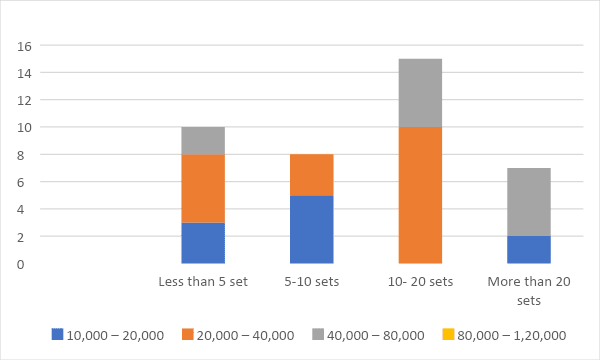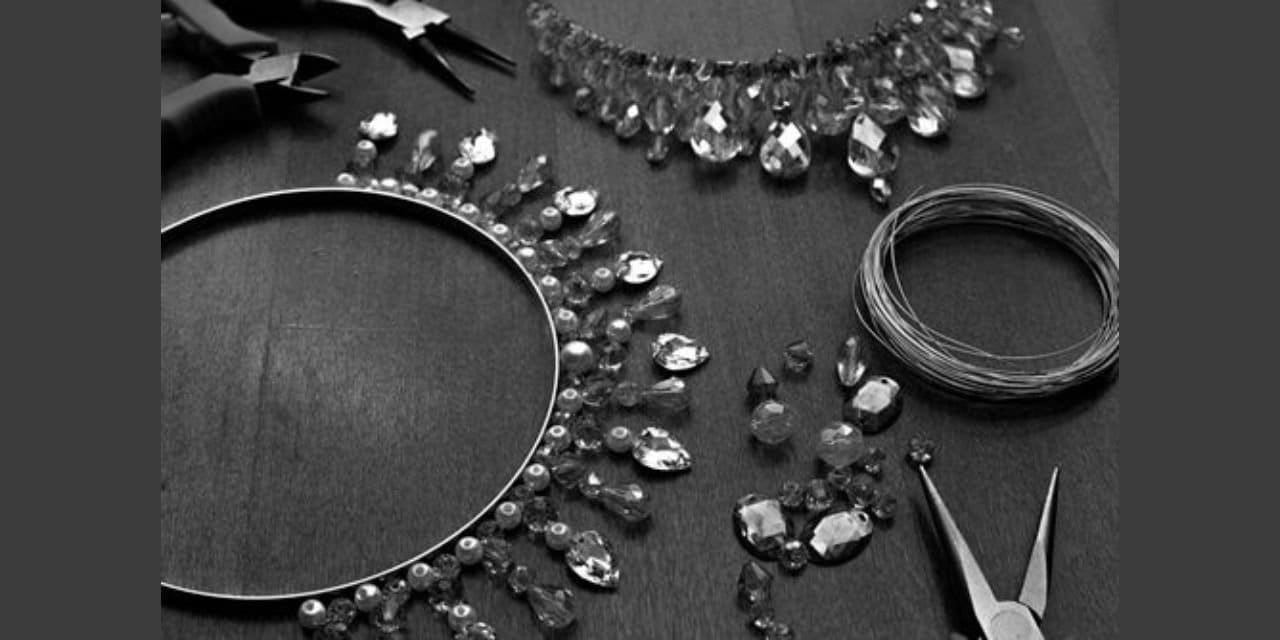Sir Vithaldas Thackersey College of Home Science
S.N.D.T Women’s University Department – Textile and Fashion Designing
Assistant Professor: Dr. Armaiti Shukla
Abstract:
Indian culture values gold jewellery for its glamour and charisma, making it the most valuable metal discovered by humans. Despite fluctuating gold prices, imitation jewellery has become popular due to the increasing demand for Indian women to wear jewellery. Imitation jewellery offers affordable accessories, mimicking the appearance of finer pieces using less expensive materials. This research paper examines the effect of imitation jewellery on real sales of gold jewellery, finding that imitation jewellery plays a significant role in the market and its sales.
Introduction:
Artificial jewellery, also known as fallalery, fashion jewellery, trash jewellery, imitation jewellery, and trinkets, is a popular form of adornments made from cheap metals and gemstones. Jaipur, India, is a hub for imitation jewelry, known for its traditional and contemporary styles. The Pink City is also known for its pearl and colored stone crafts and Kundan and Meenakari jewellery, which feature gold enameling. While genuine jewelry holds spiritual and cultural significance, fake or counterfeit jewelry is gaining popularity due to its practicality and affordability. The constant evolution of fashion also poses a challenge for genuine jewelry to remain competitive.
Artificial jewelry is made of solid materials, making it stronger and more resilient than real jewelry. Both come in fashionable and elaborate patterns, but most imitation jewelry is made of brass or copper, which is more durable over time. It doesn’t require much upkeep, as its parts are strong and self-contained. Real jewelry requires careful cleaning, polishing, and storage, while imitation jewelry is more affordable and adaptable. Both types of jewelry come in a wide variety of designs, styles, and low-cost metals, making them suitable for almost any occasion and style. In summary, imitation jewelry has become more popular than real jewelry in recent years.
Working with a knowledgeable jeweller on metal cutting, welding, casting, stone-setting, enamelling, polishing, and digital technologies ensures understanding of the advantages and disadvantages of various materials and their body fit.
Artificial jewellery is made from various materials, including stainless steel, brass, silver-plated, gold-plated, copper, copper, copper, copper, and zinc. Stainless steel is strong, resilient, hypoallergenic, and resistant to tarnish, corrosion, and scratches. Brass, an alloy of copper and zinc, is a popular choice for its warm-gold tone and affordability. Silver-plated jewelry is elegant, lightweight, and easy to maintain, with a thin layer of sterling silver applied to a base metal. Gold-plated jewelry, covered in a thin coating of gold, offers an opulent appearance and is ideal for special events. Copper is a popular choice due to its anti-inflammatory qualities and warm, reddish-brown tone, matching all skin tones. Zinc is a reasonably priced and adaptable metal used for costume jewelry due to its malleability and softness, making it suitable for intricate patterns and shapes. Overall, the use of these materials in creating fake jewelry is growing, with various metals and materials being used in various ways.
Statement of the problem:
The global economic crisis has increased the risk of robbers and thieves, but fashion-conscious individuals still wear jewelry. Imitation jewelry offers a secure and convenient option for important occasions, matching with dresses and offering a variety in design, material, price, and trends. Customers can buy as many sets as they can, and it is essential to know the proper disposal of artifical jewelry and their effects on landfill. Imitation jewellery should meet customer expectations, with beautician surveys aiding in understanding better quality products, easy cleaning, and disposal methods.
TITLE OF STUDY:
Disposal of artificial jewelry by beautician.
AIM OF STUDY:
- To explore how disposal of artificial jewelry are done by beautician.
- Investigate the methods of discarding artificial jewelry.
- To discuss the types of jewelry discarded by beautician.
OBJECTIVES of study :
- To identify the types of jewellery, used by beauticians.
- The raw material used in creating artificial jewelry.
- To study which is the better way to discard artificial jewelry.
Scope of Study:
The study investigates beauticians’ behavior in disposing of artificial jewelry, aims to improve disposal methods, and fulfill customer expectations. It also aims to establish a better relationship between metals and land.
VARIABLE:
| INDEPENDENT | DEPENDENT |
| Jewellery | Way of disposal |
| Beautician | No. of jewellery |
| Cost | Types of costumers |
| Types of raw material | Care of jewellery |
Research methodology:
The study investigates beautician behavior regarding the disposal of imitation jewelry in various shops, using a convenience sample of 20 beauticians as a non-random sample to gather available opinions.
Sources of data:
The study utilized both primary and secondary data sources, with primary data collected through questionnaires from various customers and secondary data from existing information found on the company and other websites.
Review of literature:
GUPTA, M. (2009) “Create a range of artificial jewelry by the use of textile material” student of M.Sc. textile designing, did a study on designing artificial jewelry utilizing low raw materials like fabric, buckram, embroidery in combination with Salma, dabka, beads sequences. Jewellery designs were inspired by traditional designs of Rajasthan jewelry.
BHATNAGAR, K. (2011) “Adaptation of Rajasthani jewelry designs for leather jewelry” conducted a study on Rajasthani jewelry designs; designs were adapted for 14 leather jewelry to create variations with the help of leather fabric and beadwork. To put a realistic look to jewelry, beadwork is used. Consumer preferences were found excellent to very good.
BHATTI, M. (2012) “Innovation in coin jewelry fashioned with enameling and semiprecious stories”, did a study on the Innovation in coin jewelry fashioned with enameling and semiprecious stories, worked on traditional jewelry of different areas like Himachal Pradesh, Andhra Pradesh, Rajasthan, Gujarat, Madras, Orissa, Maharashtra, etc. to give a new look to the jewelry
CBI (2015) Imitation jewelry has been made of cut and uncut stones, plastic beads, cast, iron, brass, nickel, and other attractive materials. It is an accessory used to highlight one’s personality, style, and ensemble.
KUMARI & ANITHA (2016) Jewelry is a type of accessory that includes necklaces, rings, bracelets, watches, and earrings, etc. Jewelry is designed for men, women, and children and can be made from a variety of different categories.
CHRISTIE ROMERO is a historian of antique, period, and vintage jewelry, as well as a certified gemmologist, lecturer, instructor, consultant, and collector. She is also the director of the Centre for Jewelry Studies. Christie Romero has participated as an appraiser of antique and period jewelry on PBS’s Antiques Roadshow
DATA ANALYSIS AND STATISTICS
To determine the uses of artificial jewellery
Artificial jewelry products used 
| Income | Less than 10,000 | 10,000 – 20,000 | 20,000 – 40,000 | 40,000 – 80,000 |
| Necklace | 0 | 10 | 5 | 0 |
| Earrings | 0 | 5 | 10 | 5 |
| Full set | 0 | 12 | 5 | 3 |
| Hair broches | 0 | 10 | 7 | 3 |
This graph helps to understand the uses of artificial jewellery . There were 5 people with income 10,000 – 20,000 who buy full set, 10 people buy necklace, 3 people buy earrings and and 2 people buy broches
| Income | 10,000 – 20,000 | 20,000 – 40,000 | 40,000 – 80,000 | 80,000 – 1,20,000 |
| Less than 5 set | 3 | 5 | 2 | 0 |
| 5-10 sets | 0 | 3 | 0 | |
| 10- 20 sets | 0 | 10 | 0 | 0 |
| More than 20 sets | 2 | 0 | 5 | 0 |


